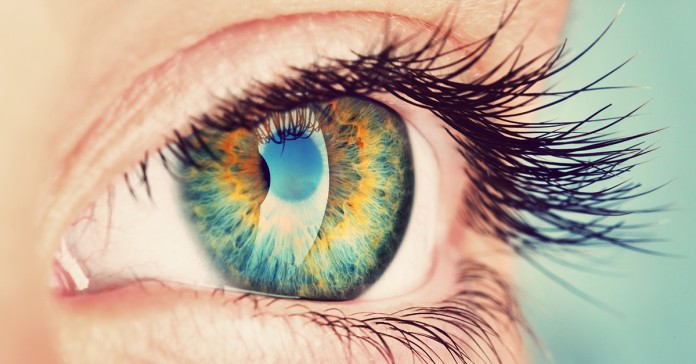“The light of the body is the eye: if therefore thine eye be single, thy whole body shall be full of light.” ~ Matthew (ch. VI, v. 22)
The Human Eye Emits Light
Look deeply into the human eye, and you are bound to get lost in its abysmal beauty. Much like mirrors facing one another in the dizzying cascade of visual infinitude, the seer gets lost in the spectacle, of which s(he) forms a part, i.e, you are an eye seeing at the same moment that you are seeing an eye; percipient and perceptible; seeing and visible.
Biophotons
That exquisite aperture – the mammalian eye – through which the light of the Universe passes into the darkest recesses of the human brain, is actually an extension of the nervous system – that like a plant – grows towards the light which nourishes it. Nourishes it how? With both energy and information, which is the very dual nature of Light.
The eyes do not age like the rest of our organs, due to the exaggerated expression of the chromosome-healing enzyme telomerase. As cells divide, important code at the end of the chromosomes can be damaged when the telomeres are sliced apart during mitosis (cell division). Like the ends of shoe strings, these telomeres are tended to and healed by the enzyme telomerase. The better shape the telomeres and the enzyme telomerase are in, the healthier will be the daughter cells following cell division, and the more long-lived and youthful these organs will be. Since the eyes have a unique level of chromosome-healing activity at their disposal, this explains so well how an aged individual’s eyes can relume brilliantly the youthful qualities of their soul.
Look closely at the image above, or at your own eyes in a reflective surface, and tell me whether or not you see that they are not simply receptacles of light and perception, but that they project their own light (i.e. their soul)?
Indeed, new research published in the Journal of Brain Research in Jan. 19 2011 show that the mammalian eye exhibits a “spontaneous and visible light-induced ultraweak photon emission.” More details:
Here, we present the first experimental in vitro evidence of the existence of spontaneous and visible light-induced ultraweak photon emission from freshly isolated whole eye, lens, vitreous humor, and retina samples from rats. These results suggest that the photochemical source of retinal discrete noise, as well as retinal phosphenes, may originate from natural bioluminescent photons within the eyes. During normal vision, the eyes are continuously exposed to ambient powerful photons that pass through various parts of the eyes, which can produce ultraweak delayed bioluminescent photons that arise from diverse parts of the eyes. Although the importance and possible role of ambient light-induced permanent delayed photons (within different parts of the eyes) during vision requires further investigation, our study may provide evidence of an origin of discrete dark noise and retinal phosphenes.
In another study published in May 2011 in the Journal of Photochemistry and Photobiology, on the bioluminescence of the mammalian eye, an explanation of “negative afterimages” is provided. A common example of a negative aftermage is the bright glow that seems to float before one’s eyes after looking into a light source for a few seconds. More details here:
The delayed luminescence of biological tissues is an ultraweak reemission of absorbed photons after exposure to external monochromatic or white light illumination. Recently, Wang, Bókkon, Dai and Antal (2011) [10] presented the first experimental proof of the existence of spontaneous ultraweak biophoton emission and visible light induced delayed ultraweak photon emission from in vitro freshly isolated rat’s whole eye, lens, vitreous humor and retina. Here, we suggest that thephotobiophysical source of negative afterimage can also occur within the eye by delayed bioluminescent photons. In other words, when we stare at a colored (or white) image for few seconds, external photons can induce excited electronic states within different parts of the eye that is followed by adelayed reemission of absorbed photons for several seconds. Finally, these reemitted photons can be absorbed by non-bleached photoreceptors that produce a negative afterimage. Although this suggests the photobiophysical source of negative afterimages is related retinal mechanisms, cortical neurons have also essential contribution in the interpretation and modulation of negative afterimages.
The light that emanates through the “window of the soul,” the human eye, is not “imagined,” but real and these biophotons contain energy and information (wave-particle complementarity of Light), capable of transforming our understanding of one another, and ourselves.
*Article originally appeared at Choose Vibrant Health.












